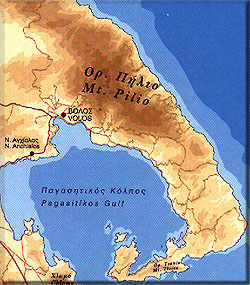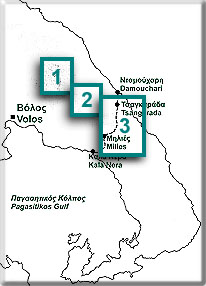| Pilio |
1.gif) |
 |
In general about Mt. Pilion Pilion lies on a peninsula of the prefecture of Magnisia extending southeast of Volos towards the Sporades islands. Its northern boundaries touch the Volos-Keramidi axis whereas its south end reaches down to Argalasti. It is ca. 44 kn in length and its width varies between 10 kn in the south and 25 km in the north. Its highest peak, at 1.624 m., is not accessible sdue to military installations. The mountain is densely wooded all over, the vegetation being far from the typical found elsewhere in Greece. Beeches, oak-trees, apple-trees and wild chestnut-trees from shadowy forests which cover the mountain from end to end. There is water streaming everywhere all year long, even in midsummer. In winter, it is often covered with snow, despite its low height, and there's even a ski resort in Chania. The villages are scattered on the west and east slopes of the mountain, lying from 0 to 500m above sea level. All are built according to local traditional architecture, making this one of the most beautiful mountain settlements in Greece compared only to the Zagoria on north Pindos. |
 |

3: map of the hiking track. |
 |
Hiking in Pilion More than 500 km of paths, trails and tracks offer many opportunities for walking in Pilion. There used to be a network of old cobbled trails linking the villages, but unfortunately these have been largely destroyed by the far too many bulldozers appearing in every corner of the mountain. However, there still remain many to hike on. The featured routes are not particularly demanding for a hiker in good physical condition. However, if you are not an experienced hiker it's better to attempt some short hikes first, to check on your abilities. The routes suggested here run mostly on well preserved cobbled trails or mountain paths with only very small stretches of dirt tracks or asphalt. The routes suggested by Road Editions are 4: We present here the second one, being the most "mountaineering". |
 |
General gear Regardless of the time of year, you should always have trekking boots on and it is also advisable to be in long pants. A small backpack with water and something to eat will offer you more freedom in your excursions. Sun glasses and a hat are also needed in summer for extra protection. Attention! These routes can become very difficult and possibly impassable in winter when there is snow. If weather conditions are bad, only experienced climbers should attempt them. |